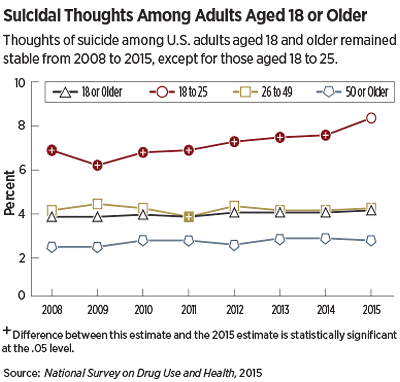A new report from the Substance Abuse and Mental Health Services Administration (SAMHSA) based on 2015 data indicates that 9.8 million of American adults aged 18 and older had serious thoughts of suicide during the past 12 months. The rates for people with suicidal thoughts were more than double when concurrent alcohol and illicit drugs use was taken into account.
“Mental health professionals and psychiatrists tend to focus on depression and other severe psychiatric disorders as the foundation for suicide,” Eric Caine, M.D., chair of the Department of Psychiatry at the University of Rochester Medical Center and a suicide expert, told Psychiatric News. “The relationship that this report underscores between alcohol and substance use and suicidal thoughts, plans, and deaths is not new, but many have not seen the tight linkage that is so evident here.”
Data for the report were generated from the 2015 National Survey on Drug Use and Health, which included information on the prevalence of serious thoughts of suicide, plans for suicide, and attempted suicide among civilian, noninstitutionalized adults within the prior 12 months of being surveyed.
The results showed that overall percentages of adults reporting suicidal behaviors have remained stable in most years since 2008. However, an increase in serious thoughts of suicide was observed among young adults (aged 18 to 25) from 2008 to 2015, rising from 6.8 percent to 8.3 percent. Similar trends for past-year planning of suicide by this group also increased in the same period, rising from 2.0 percent to 2.7 percent, while the rate of suicide attempts rose from 1.2 percent to 1.6 percent. Females in this age group were more likely than their male counterparts (2.0 percent vs. 1.3 percent) to attempt nonfatal suicide.
In addition to having higher levels of suicidal thoughts, people who engaged in alcohol use and illicit drug use in the past year also had significantly higher levels of suicidal planning and nonfatal suicide attempts than the general adult population. For example, 9.8 percent of those who used alcohol and illicit drugs in the past year had serious suicidal thoughts compared with 4 percent of all adults.
The report also showed differences in risk for suicidal behaviors among people who used certain types of illicit drugs. People who used methamphetamines in the past year were most likely to report serious thoughts of suicide, at a rate of 21.6 percent; those who misused prescription tranquilizers were more likely to have made plans for suicide, at a rate of 7.9 percent; and people who used inhalants were more likely to have made nonfatal suicide attempts, at a rate of 5.6 percent.
Suicidal behaviors were also significantly increased in people who had experienced a past-year major depressive episode.
In terms of treatment for suicidal behaviors, 49 percent of adults who had serious thoughts of suicide in the past 12 months received mental health services. People who made nonfatal suicide attempts had a higher rate of mental health treatment, 60.4 percent.
Caine told Psychiatric News that despite the concerning rates of suicidal behaviors in the United States, policymakers have not been fully committed to increasing efforts to address these issues.
“While it is notable that the government has asked for more funds for SAMHSA [to address behavioral and mental health issues], the amount is tiny compared with what the nation spends on other conditions. To reduce suicidal behavior, the same types of public health initiatives are needed that have served so well for conditions such as heart disease, HIV/AIDS, and cancers,” Cain concluded. ■
“Suicidal Thoughts and Behavior Among Adults: Results From the 2015 National Survey on Drug Use and Health” can be assessed
here.

